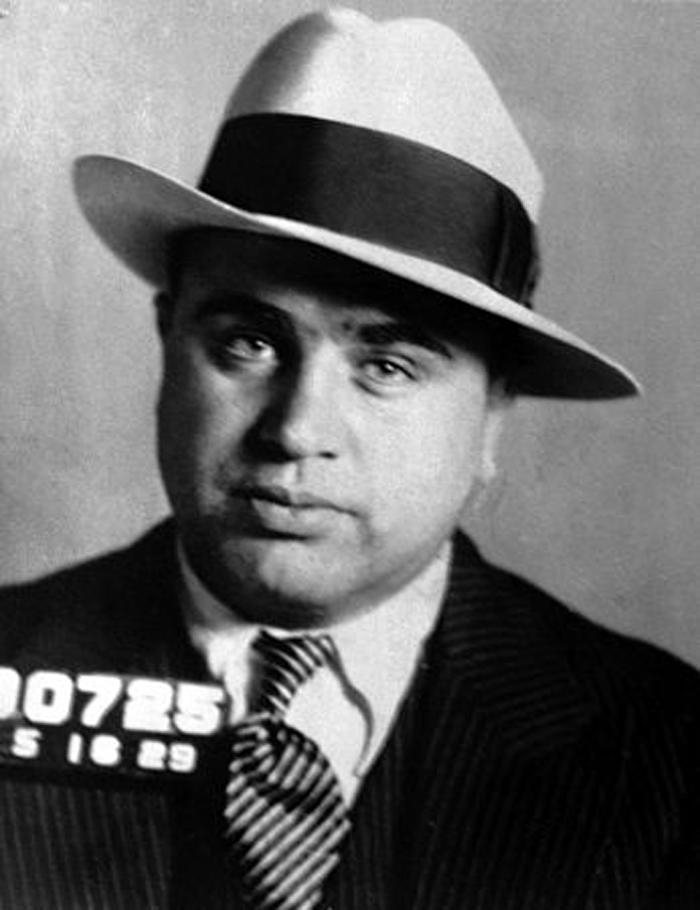
Source: FBI
On 17 October 1931, Alphonse Gabriel Capone (commonly known as Al Capone or Scarface), an American gangster who had achieved notoriety as the boss of the Chicago Outfit, was convicted of tax evasion. It ended the reign of one of the most notorious criminals of the 1920s and 1930s.
The son of Italian immigrants and originally from Brooklyn, New York he went to Chicago in 1920 where he was helping crime boss Johnny Torrio run his illegal enterprises. The 18th Amendment, commonly called Prohibition, had come into effect in January 1920. Under this law (called the Volstead Act), the manufacture, transportation, and transportation of alcohol was banned. Passed as means to end the terrible effects of alcohol intoxication and addiction, it instead allowed the rise of criminal enterprises that dominated the 1920’s. From illegal production or importation of alcohol to operating places to drink (speakeasies), it poured millions into criminal enterprises.
While other criminal activity still went on (smuggling, gambling and prostitution), alcohol was the biggest income producer for gangs such as Torrio ran. When Torrio retired in 1925, Capone took over control. Capone had to deal also with rival gangs such as Bugs Moran. Violence between gangs was often in public and bloody culminating in the infamous St. Valentine’s Day Massacre in 1929. Bugs Moran would have been there but saw a police car and left thinking it was a raid. In fact, it is believed that the men, dressed as policemen and associated with the Capone gang, shot the seven men associated with the Moran gang. It officially remains unsolved, but most believe Capone responsible for the murders.
The St. Valentine’s Day Massacre became national news and with Capone’s alleged association to it, his notoriety increased. Capone had relied on bribing city officials, intimidation and various hideouts to avoid arrest. He did spend 10 months in Holmesburg Prison in Philadelphia for carrying a concealed handgun but ran his operation from jail. The effect though of the St. Valentine’s Day Massacre was to bring the federal government into the situation. From corrupt city officials, police, and magistrates, the case was made the city was under the control of gangsters like Capone. President Hoover directed federal agencies concentrate on Capone and his allies.
Using a multi-agency approach, the Treasury and Justice Departments came up with plans on that attacked from two sides. First was to attack the gangsters for income tax evasion and then second to use small elite squads of Prohibition Bureau agents (this included the famous Eliot Ness) to be used against the bootleggers. William A. Strong, publisher of the Chicago Daily News (and who had urged Hoover to act), used his newspapers resources to gather intelligence to aid the investigations. The famous Untouchables in Chicago led by Eliot Ness were responsible for trying to inflict economic damage on his organization. Unlike what was shown in the movie The Untouchables, it was a large unit and the income tax angle was done elsewhere.
As the treasury bore down on him, Capone tried get his tax records into shape to prevent going to jail. He offered to pay for certain years in hopes of a reduced sentence and fine. A letter from his lawyer conceding large taxable income was a great gift to the prosecution. With a ledger and his accountant, the government position was to imply his control. Capone’s spending was presented to paint a vivid picture of someone who lived quite large having access to large sums of money to spend. It worked. He was convicted of evading $215,000 in taxes with an income of $1,038,654 during a five-year period. Judge Wilkerson gave him the maximum penalty for the five counts: 11 years. He was also fined $50,000, $7,692 in court costs, and interest on the $215,000 that had not been paid.
His career as head of the Chicago Outfit would be at an end. He was sent to the Atlanta U.S. Penitentiary in May 1932. However, Judge Wilkerson became concerned when he got reports of special treatment. Capone was suffering from both syphilis and gonorrhea. He had taken cocaine and suffered withdrawal symptoms as well. He was transferred to Alcatraz in August 1934. Due to neurosyphilis that eroded his mental faculties, he would spend most of his time in the hospital section. After completing his term in January 1939, he was sent to another facility to serve out his contempt of court sentence. He would be paroled in November 1939 and received treatment at Union Memorial Hospital.
After treatments, he would go to Palm Island Florida where he remained for the rest of his life. He got treatments with the newest mass-produced drug called penicillin. It could not reverse his disease but helped him lived longer. He would die from heart failure on 25 January 1947. He was originally buried at the Mount Olivet Cemetery in Chicago. His remains were later removed (along with his family’s) to Mount Carmel Cemetery in Hillsdale, Illinois.
Aftermath
With the repeal of the 18th Amendment with the adoption of the 21st Amendment in December 1933, Prohibition had come to an end. Only a few states choose to remain dry (that would change much later) ending the income for illicit alcohol that had given rise to gangs like the Chicago Outfit. Organizations like Chicago Outfit would take a quieter approach and avoid public violence to avoid either local or federal police investigations. These organizations focused on prostitution, union racketeering, and gambling after the Capone years. In later years, much to the chagrin of J. Edgar Hoover of the FBI, it would be found these criminal organizations had become very powerful and worked together.
Sources
Al Capone
Al Capone | Biography, Life, Death, Alcatraz, Syphilis, and Facts.” Encyclopedia Britannica, 17 Oct. 2023, www.britannica.com/biography/Al-Capone
“Al Capone Goes to Prison.” HISTORY, 24 Nov. 2009, www.history.com/this-day-in-history/capone-goes-to-prison]
Wikipedia contributors. “Al Capone.” Wikipedia, Oct. 2023, en.wikipedia.org/wiki/Al_Capone
St. Valentine’s Day Massacre
“St. Valentine’s Day Massacre – Victims, Evidence and Suspects.” HISTORY, 9 Nov. 2009, www.history.com/topics/crime/saint-valentines-day-massacre
“Saint Valentine’s Day Massacre | Victims, Al Capone, Bugs Moran, and Prohibition.” Encyclopedia Britannica, 18 Sept. 2023, www.britannica.com/event/Saint-Valentines-Day-Massacre
